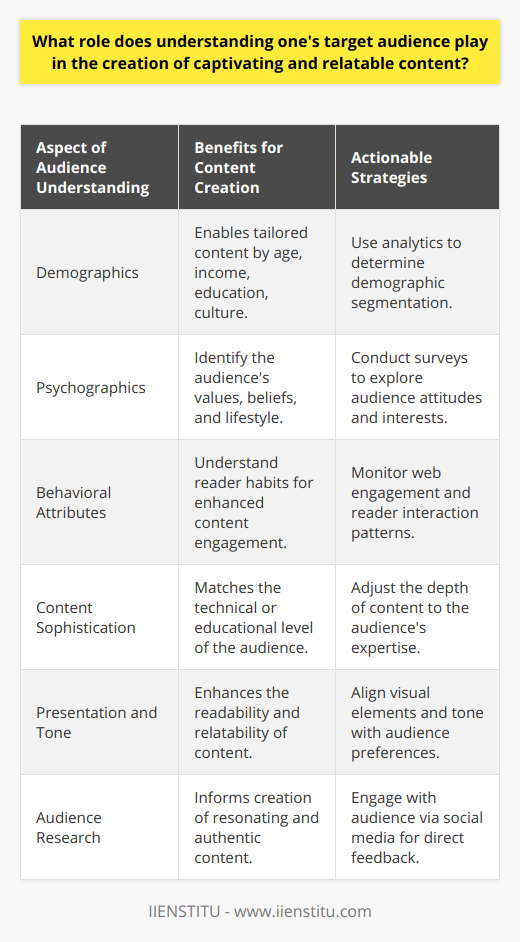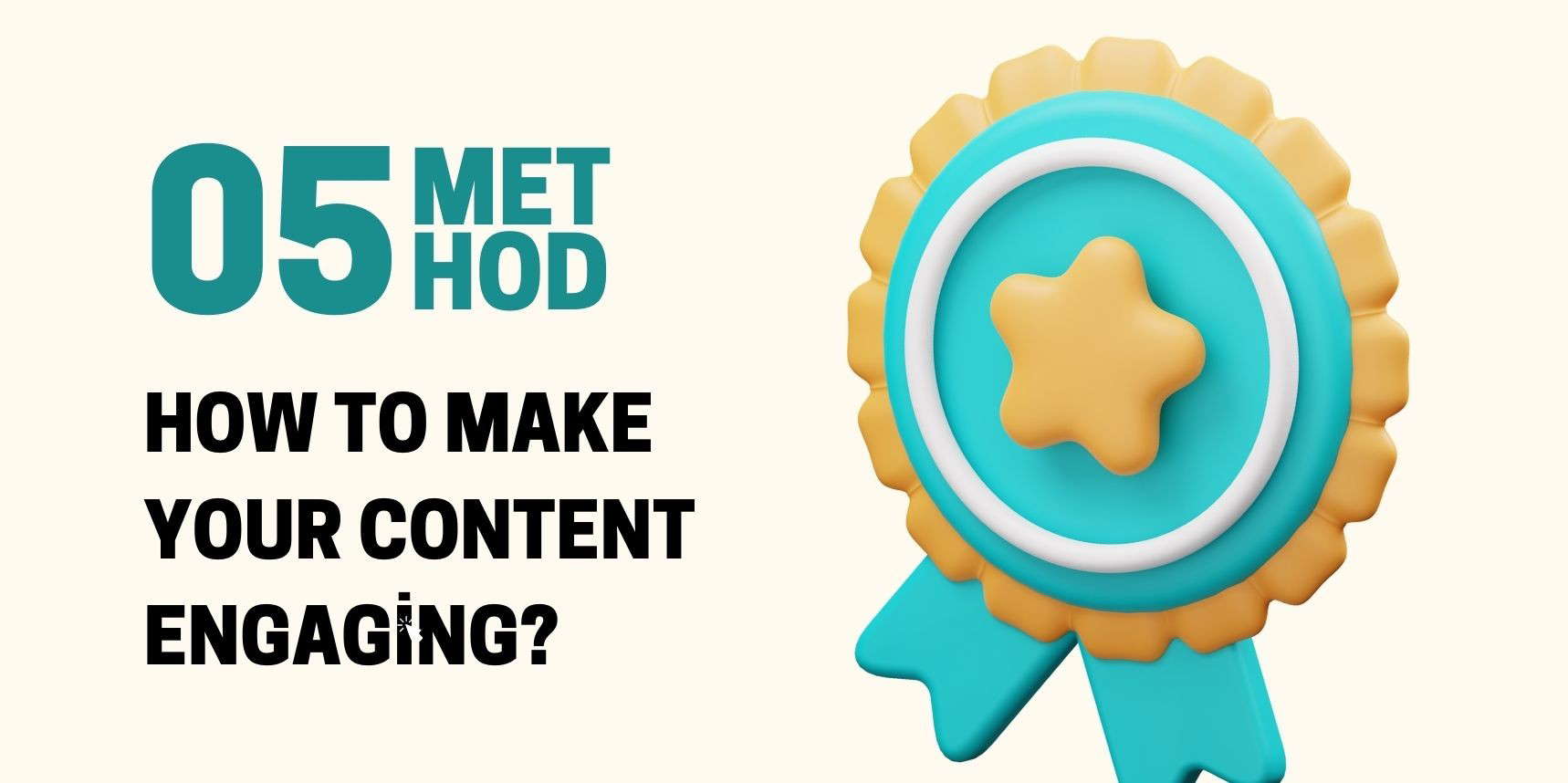
Are you a blogger, writer, or content manager? Do you feel your article is boring and not engaging enough even though it has a lot of good points to share with the world?
You are not alone. There's so much advice about counterintuitive concepts from people who have been at this for years. You may have heard some of them:
Write a controversial post
Be original and break the rules
And perhaps you have also heard about this technique: hook someone with your opening line. And then, all of a sudden… it has nothing to do with what you were saying! It doesn't even come close. It is just something that may be relatable to the content but not strictly related.
Don't worry; there's another method that can help you build a bridge from that starting point to your main topic without creating a detour or wasting time on lengthy explanations.
This method is called "topical relevancy," In this article, I will teach you how to use it through examples and easy steps.
But first, what is topic relevance?
Topical relevancy in content means that you connect your topic and something happening in the world. It can be a news story, an event, or even something as simple as a trend. When you connect your content to something that people are interested in, you provide them with a reason to read it. You are also giving them an away understand it better.
For example, you provide topical relevancy if you write about the economy and mention the recent stock market crash. Likewise, if you are writing about parenting and the current debate over whether or not to vaccinate children, you are delivering topical relevance.
When creating your content, you need to find topical relevancy to keep people interested in what you have to say.
The following step-by-step guide will show you just how topical relevancy works and how you can use it in your writing.
Step 1: Identify the relevance of the topic to your readers
Before you even start writing your piece, ask yourself this question: "why does my reader care about this?" This is important because it's hard for them to feel engaged without knowing why they want to read it.
For example, when we talked about the stock market crash during Step 1, we said that you provide topical relevancy if you mention something like that at the beginning of your article. But what does that mean for the reader?
It means that they can understand the article better because they will see its relevance to what is happening in the world. It also means that they are more likely to continue reading because they are interested in finding out more.
Step 2: Find a news story or event related to your topic.
Once you have identified the relevance of your topic, it's time to find a news story or event that is related to it. This can be something happening right now or something that has happened in the past.
For example, if you are writing about parenting, you could choose a news story about a debate that is happening right now. If you write about the economy, you could select a news story about the stock market crash.
The key is to find a story that your reader will be interested in.
Step 3: Connect the story to your topic
Now it's time to connect the story to your topic. This is where you explain how it is relevant and why it matters.
For example, if you write about the stock market crash, you could say something like this: "The stock market crash is important because it shows us how quickly things can change."
If you are writing about parenting, you could say something like this: "The debate over whether or not to vaccinate children is important because it shows us how difficult parenting can be."
After writing this, your reader will see that the story is related to the topic and why they should continue reading.
Step 4: Make a conclusion or suggestion based on what you've learned.
Finally, make a statement to show your reader how everything fits together and what you want them to know. For example, if we were writing about the economy, we could say something like this: "The stock market crash shows us how quickly things can change and also highlights the unpredictability of life."
If we were writing about parenting, we could say something like this: "Although the debate over whether or not to vaccinate children is controversial, it serves as a reminder of what is truly important."
This step is essential because it gives your reader a reason to keep reading.
Step 5: Make sure you incorporate the following elements into your writing.
Finally, you need to make sure that you are incorporating the following elements into your writing to engage your readers :
Opinion words - these give them an insight into why you feel how you do about this topic Language - using descriptive language will help them visualize what is happening in the news story Evaluation - showing them why they should care about this story is critical Details - providing them with specific information helps them understand everything better Tone - when doing research, be careful not to use polarizing language when describing individual ideas Personal experience/stories - using personal accounts can help readers connect with the topic on a deeper level.
When writing, make sure you use these elements to keep your readers engaged. If you are struggling to incorporate them into your writing, try using a thesaurus to find different words that you can use.
Remember, the most important thing is to be clear and concise. You don't want to overload your readers with too much information at once. Instead, focus on one or two points and go from there.
The key is to keep practicing and always be aware of how to improve your writing. Remember, engaging content is vital if you want your readers to stick around!
To be engaging, you need to do the following:
Find a relevant news story or event
Connect the story to your topic
Make a conclusion or suggestion based on what you've learned
Make sure you are incorporating the following elements into your writing (opinion words, language, evaluation, details)
Remember that engaging content is vital if you want your readers to stick around!
Articles usually incorporate all of these elements to keep their reader's attention. However, essays only use one section at once. So, for example, they might talk about two different topics (find a relevant news story/event and connect it), but then only make one point (conclude or based on what you've learned). To be a great writer, you need to do all of these things at once.
This is why it is essential to practice and always be aware of improving your writing. Remember, engaging content is vital if you want your readers to stick around!
Engaging content is vital if you want people to stick around and read what you have written. You can use specific techniques to make your content more interesting for your readers.
One way to make your content more engaging is to find a relevant news story or event and connect it to your topic. This will help your readers see how the report relates to their interests. Additionally, it will help them understand the subject better.
Another way to make your content more engaging is to create a conclusion or suggestion based on what you've learned. This will help your readers see how they can apply what they've learned to their own lives. Additionally, it will help them understand the topic better.
Finally, make sure you incorporate the following elements into your writing: opinion words, language, evaluation, details. These elements will help your readers connect with the story deeper and understand it better. Remember, the most important thing is to be clear and concise. You don't want to overload your readers with too much information at once.
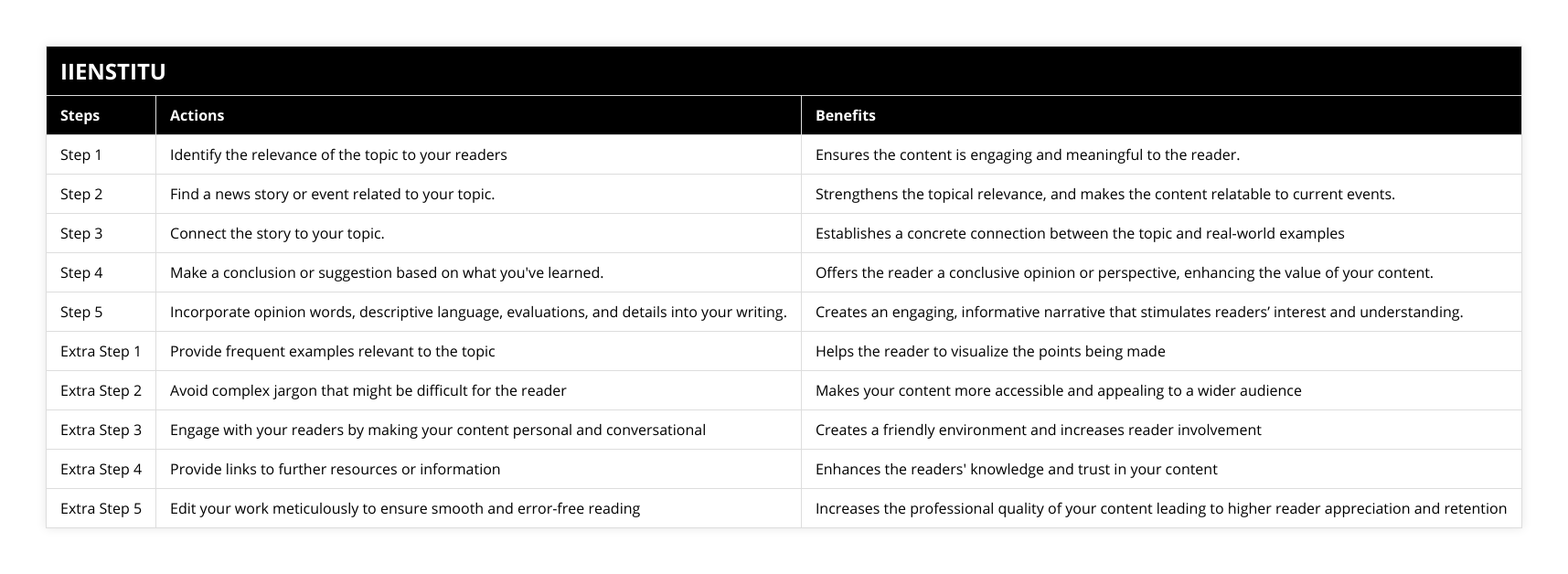
Frequently Asked Questions
How to make your content engaging?
Engaging content is the lifeblood of digital marketing, so to come up with engaging ideas you’ll need to first identify your business goals and target audience or persona.

What are some quick ways to create engaging content?
The best and most engaging content is the sort of content that requires people to invest their time in it. Here are a few ideas: Posing questions, making deals, giving challenges, asking for opinions or advice, introducing us to your friends and family, telling stories. Create content that people want to put time into! Maybe start by posing questions or giving deals. And if you're interested in other tips on how we can create more engaging content on.

How can I find new and innovative way to engage my followers in my content?
Sometimes a new and innovative way to engage your followers in your content is with a deep dive into one topic for a whole month. People like variety, but they often love to get really good at expert level knowledge of one subject. For example, why not give it all you've got for 30 days on cooking with garlic? By day six or seven, people will be scrambling to catch up with you! Passover is coming up soon, don't forget this could make for some fun Passover themed posts (think matzah pizza crust). Whatever holiday season comes around next year (Valentines Day?) you'll already have the content ready! The best part about taking these different approaches is that there's no "wrong".
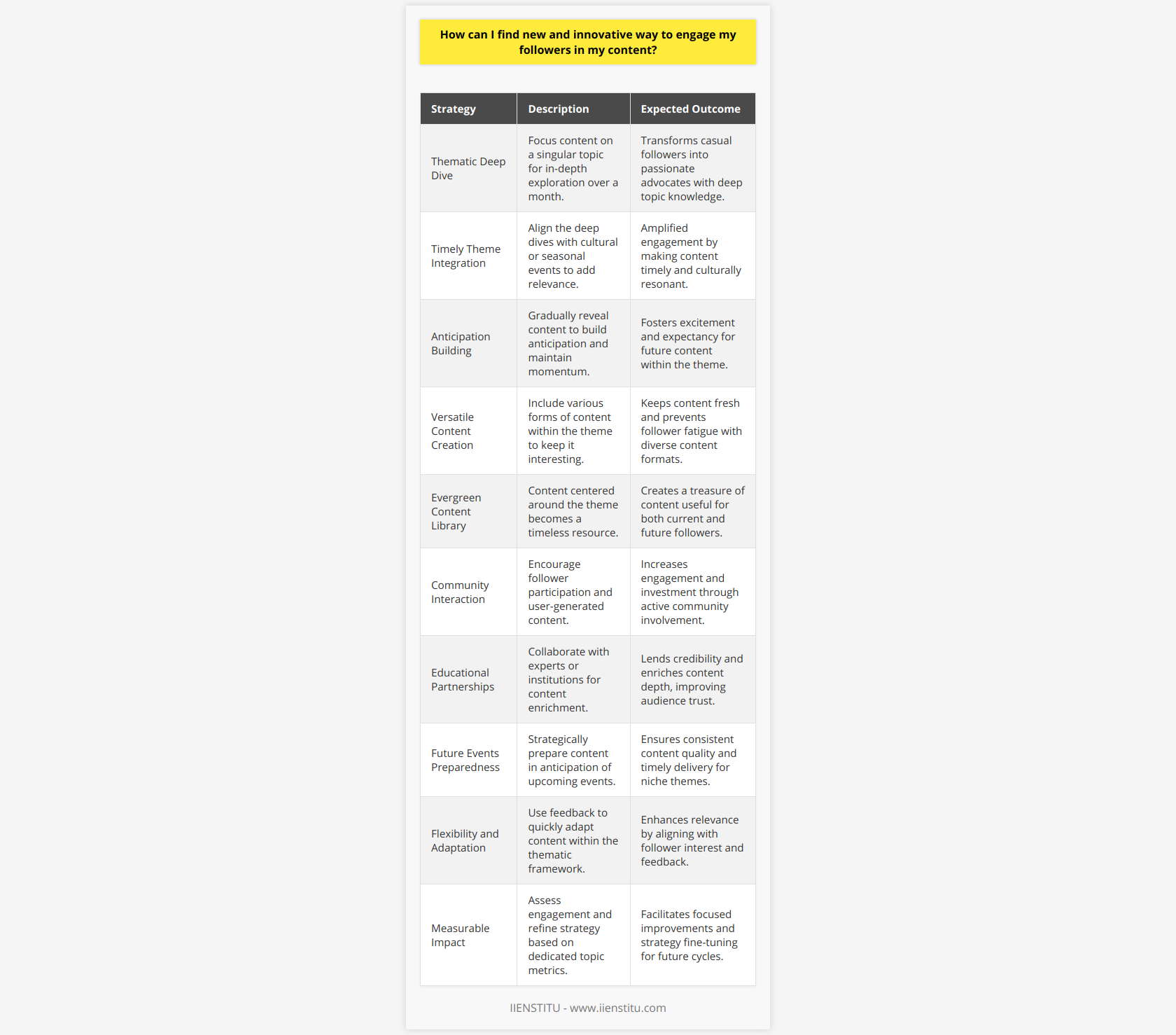
Why is my content failing to capture the audience's interest?
Limited Understanding of the Target Audience
A primary reason for content failing to capture the audience's interest is the limited understanding of the target audience. Profiling the intended readership, identifying their preferences, and crafting content based on their expectations significantly improves content reception. Investing time in understanding reader demographics, behavior, and preferences can create more engaging content.
Inadequate Keyword Research
Another reason for content underperformance is inadequate keyword research. This involves using phrases that do not resonate with the target audience or neglecting to prioritize high-converting, low-competition keywords. Such keywords help generate organic traffic and impact reader interest. Therefore, it is crucial to perform thorough keyword research before creating content to ensure visibility and relevance to the audience.
Lack of Engaging Elements
The absence of engaging elements also hinders content effectiveness. Integrating multimedia elements, such as images, infographics, or videos, enhances content appeal and increases the reader's likelihood of engaging with the post. Additionally, employing compelling storytelling techniques, anecdotes, or real-life examples helps in generating interest and retaining the audience's attention throughout the blog post.
Non-Compelling Headlines
Undeniably, headlines play a significant role in capturing the audience's interest. Writing non-compelling headlines may result in low click-through rates and audience engagement. Implementing powerful headlines that trigger curiosity and promise value to the reader is essential to entice the audience to read the entire blog post and retain their interest.
Poor Formatting and Readability
Lastly, poor formatting and readability can dissuade readers from engaging with the content. Ensuring proper utilization of subheadings, bullet points, and short paragraphs can significantly improve the readability of the blog post. Providing a seamless reading experience by maintaining an appropriate font size, line spacing, and color contrast also aids in capturing the audience's attention.
In conclusion, understanding the target audience, performing keyword research, employing engaging elements, crafting compelling headlines, and ensuring good readability are factors critical to captivating the audience's interest. By addressing these issues, a blogger can create content that appeals effectively to their intended readership, increasing the chances of audience engagement and returning visitors.

What strategies can I employ to develop compelling content for my readers?
Understanding Audience Needs
To develop compelling content for readers, it is essential to understand their needs, preferences, and interests. Conducting market research, utilizing social media platforms, and interacting with blog subscribers can provide valuable insights to tailor content to meet reader demands.
Creating Engaging Headlines
Attention-grabbing headlines encourage readers to explore further. Crafting catchy, concise, and informative headlines is crucial in capturing reader attention, inviting curiosity and promoting content consumption.
Developing Appealing Visuals
Incorporating relevant visuals, such as pictures, infographics, and videos, enhances content appeal and readability. These visual elements break the monotony of large text blocks and assist in effectively conveying complex information to readers in a simplified manner.
Utilizing Storytelling Techniques
Stories have a unique ability to engage and captivate readers, fostering emotional connections that resonate on a personal level. Implementing storytelling techniques – such as sharing anecdotes, real-life experiences, or case studies – can enhance content impact and strike a chord with readers.
Establishing a Conversational Tone
Creating content in a conversational tone makes it relatable, facilitating reader engagement and comprehension. Using simple language, addressing readers directly, and posing rhetorical questions provoke reader interaction, weaving an engaging narrative that holds their interest.
Backing Content with Facts and Data
Presenting well-researched, credible content with relevant facts, figures, and data adds value to the reading experience. Publishing such content highlights the author's expertise, improving reader trust and making the content more compelling to readers seeking reliable and updated information.
Providing Actionable Advice
Offering practical, actionable advice to readers enhances the blog's relevance, helping readers draw tangible benefits from the content. This increases reader satisfaction and loyalty, as they perceive the content to be useful and purposeful.
In conclusion, understanding reader needs and preferences, crafting engaging headlines, incorporating appealing visuals, utilizing storytelling techniques, establishing a conversational tone, adding credible data, and providing actionable advice are essential content strategies to captivate and retain reader attention. These approaches ensure the creation of compelling content that fosters reader loyalty and satisfaction.
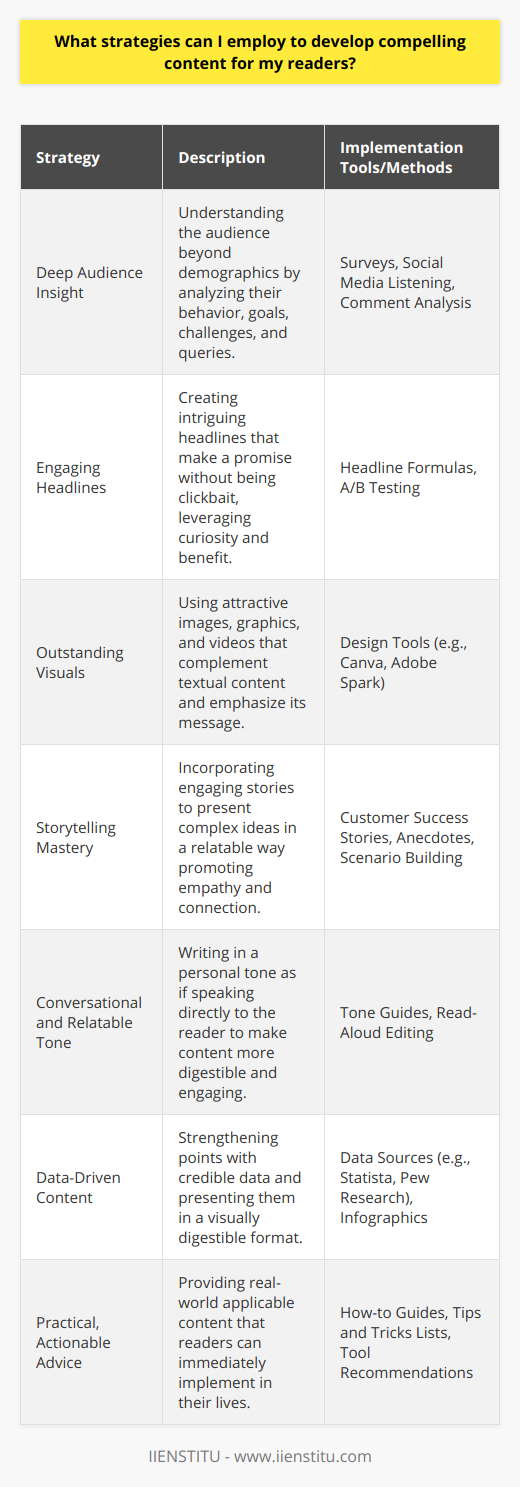
How can one effectively boost engagement levels through social media postings?
Optimizing Content for Maximum Engagement
In today's digital age, boosting engagement levels through social media postings is crucial for amplifying online presence, resonating with target audiences, and increasing the visibility of a blog post. To achieve optimal engagement, it is essential to focus on strategies that entail devising an effective posting schedule, creating compelling content, and fostering genuine interaction within the community.
Strategic Posting Schedule
A well-thought-out posting schedule can significantly impact a blog's visibility and reach across various social media platforms. Sharing content on different platforms at peak times of user activity ensures increased views, shares, and engagement metrics, thus maximizing exposure. A proper posting frequency also contributes to maintaining a consistently engaged audience, reducing the risk of content fatigue and follower disinterest.
Compelling Content Creation
Creating captivating content that elicits user interest is vital for boosting engagement levels. Vitally, content should resonate with the target audience, inciting reactions such as likes, shares, and comments. In this context, the utilization of visual elements enhances the content's appeal, making it more shareable and relatable. Additionally, leveraging popular formats such as videos, infographics, and polls can immensely aid in fostering engagement, ultimately encouraging users to participate actively.
Authentic Community Interaction
Meaningful interaction with the target audience is fundamental to boosting engagement levels through social media postings. By acknowledging and responding to comments, opinions, and messages from followers, a genuine sense of community can be cultivated. Prioritizing audience feedback and incorporating their inputs into content creation processes can lead to a more loyal and engaged following. Lastly, collaboration with influencers or hosting user-generated content competitions can catalyze further growth of the community and maximize engagement.
In conclusion, maximizing social media engagement levels necessitates adopting a strategic posting schedule, creating compelling content, and genuinely interacting with the target community. These strategies work collaboratively to pique user interest and foster a loyal and engaged following, amplifying the blog's overall visibility and enhancing its potential to generate new interest.
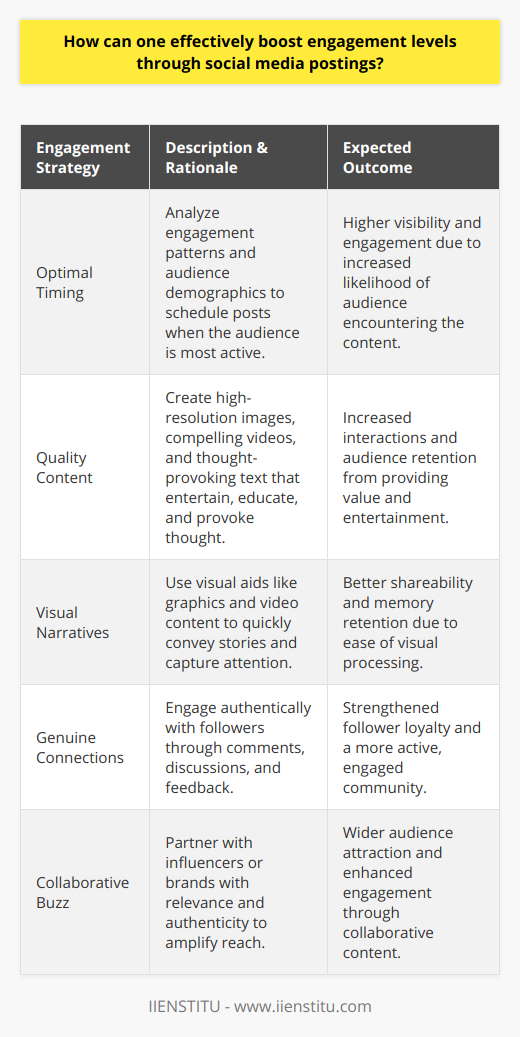
What factors contribute to the perceived effectiveness of content engagement?
Factors Impacting Perceived Effectiveness
The perceived effectiveness of content engagement in a blog post can be attributed to several factors, many of which can fall under content characteristics, user preferences, and contextual aspects.
Content Characteristics
First, the relevance and quality of the content significantly impact the perceived effectiveness, as readers will engage more with content if they find it informative, useful, or entertaining. Another essential factor is readability, determined by aspects such as sentence length, text complexity, and formatting. Shorter sentences and simpler vocabulary can enhance the message's clarity and, therefore, its engagement. Additionally, the visual appeal of the blog post, including images, colors, and layout, contribute to attracting and retaining the reader's attention.
User Preferences
Second, user preferences play a key role in driving content engagement. Personal factors, such as individual interests, demographics, and past experiences, can influence a reader's perception of the effectiveness of the content. Therefore, content creators must understand their target audience and tailor the content accordingly. Additionally, the user's motivation and intention for engaging with the content play a crucial role. For example, readers seeking information for a specific purpose might have different expectations than those browsing for entertainment.
Contextual Aspects
Finally, contextual aspects can significantly contribute to the perceived effectiveness of content engagement. These aspects include the accessibility and navigability of the website, the credibility and reputation of the author, and the emotional or social context around the content. For instance, readers who perceive the author as credible and well-informed will likely engage more with the content.
In conclusion, the perceived effectiveness of content engagement in a blog post can be influenced by several factors, including content characteristics, user preferences, and contextual aspects. Content creators must understand their target audience, invest in the quality of the content, and account for contextual factors to achieve better engagement rates.

How do psychological principles play a role in creating captivating content?
Understanding the Human Psyche
Psychological principles provide valuable insights into understanding how individuals perceive, process, and react to information. Leveraging these principles can significantly enhance the creation of captivating content for a blog post.
Cognitive Biases and Attention
Cognitive biases, such as the confirmation bias and the availability heuristic, influence our decision-making processes and affect our attention to specific subjects. Creating content that appeals to these biases can increase its relevance and the likelihood of attracting a wider audience. For instance, content featuring current events or popular culture, which are readily available in people's minds, can provoke curiosity and engagement.
Emotional Resonance
The emotional resonance of content is another essential factor in capturing the audience's interest. Emotions, such as happiness, surprise, or fear, can elicit strong reactions and increase the intensity of the reading experience. Incorporating relatable stories, vivid imagery, or thought-provoking questions in blog posts can evoke emotions and facilitate a deeper connection with the content.
Social Influence and Persuasion
Social influence and persuasion theories explain how people conform to the opinions, behaviors, or preferences of others. By referencing experts or citing popular trends, a blog post can increase its credibility and appeal, persuading readers to engage more actively. Furthermore, persuasive communication techniques, such as using a conversational tone and providing compelling evidence, can help persuade the audience to adopt specific perspectives or actions.
Memory and Retention
The ability of content to leave a lasting impression on the reader depends on its memorability. Mnemonic devices, such as repetition, chunking, or the use of acronyms, can simplify complex information and enhance retention. Moreover, incorporating meaningful visuals or interactive elements can stimulate readers' sensory experiences, making it easier for them to recall the content later.
In conclusion, effective blog posts incorporate psychological principles at various levels, influencing attention, emotions, social interactions, and memory processes. Understanding the nuances of human psychology and applying them strategically in content creation can generate a captivating and enriching experience for readers.
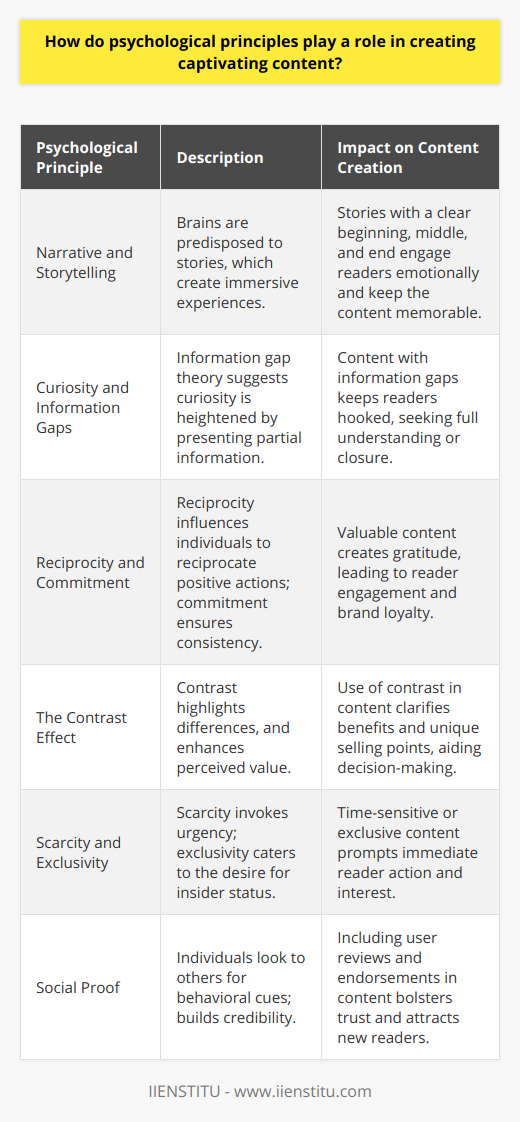
Can utilizing storytelling techniques significantly enhance the relatability and overall appeal of written content?
Storytelling Techniques in Blog Posts
Effect on Appeal and Relatability
Utilizing storytelling techniques can significantly enhance the relatability and overall appeal of written content, especially in blog posts. The narrative structure employed in storytelling allows readers to connect with the content on a deeper level, fostering emotional investment in the topic being presented. By incorporating storytelling elements such as character development, a compelling plot, and rich imagery, blog authors can create an engaging and immersive reading experience that captures the readers' interest.
Emotional Resonance
One of the key aspects of storytelling is its ability to evoke emotions in readers. When blog posts contain emotional elements, readers are more likely to resonate with the content, resulting in increased engagement and memorability. By weaving personal anecdotes, empathetic language, and vivid descriptions into the fabric of their writing, authors can create an emotional connection between the reader and the topic, significantly enhancing the appeal of the content.
Contextualization and Relevance
Integrating storytelling techniques also enables writers to contextualize their content, making it more relevant and relatable to their target audience. By framing the topic within a narrative structure that reflects readers' own experiences, cultural norms, or current events, authors can communicate their ideas in a manner that resonates with the audience's worldview. This contextualization helps readers understand the topic more clearly and appreciate its relevance to their lives, increasing the overall appeal of the blog post.
Reader Retention and Recall
Additionally, the narrative structure of storytelling enhances reader retention and recall, as the human brain is wired to process information through storytelling. Incorporating a compelling narrative in a blog post aids in the organization and retention of the information presented, as it engages the reader's cognitive processes associated with story comprehension. This increased retention and recall translates to a lasting impact and higher likelihood of information-sharing among readers, which in turn boosts the blog post's appeal.
Conclusion
In summary, incorporating storytelling techniques into blog posts significantly enhances the relatability and overall appeal of the content. Engaging readers through emotional resonance, contextualization and relevance, and improved retention and recall enriches the reading experience, making the content more memorable and shareable. Consequently, authors should consider employing storytelling methods to elevate their blog writing and engage their audience effectively.
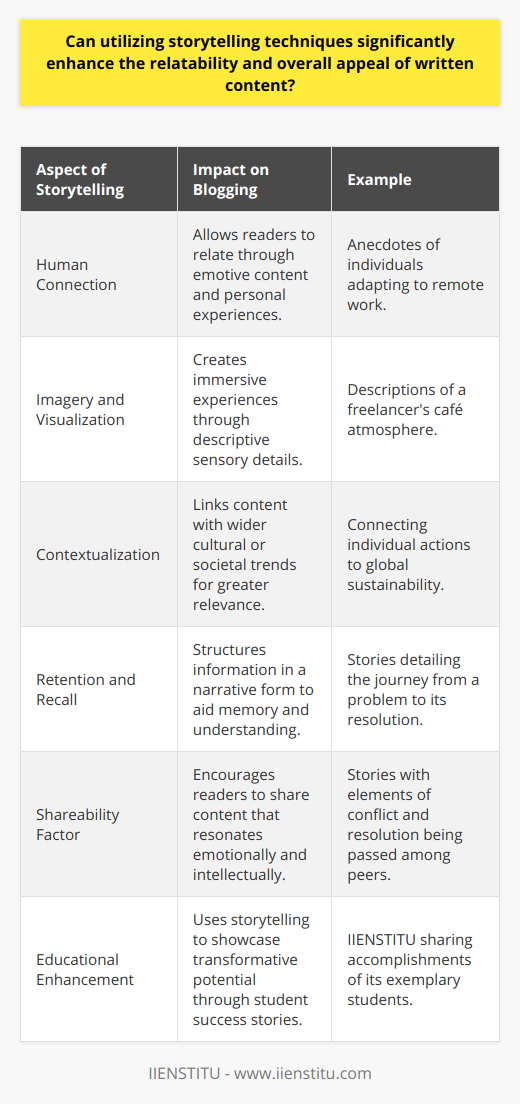
Why is my content not engaging?
Lack of Audience Understanding
One of the primary reasons for content not being engaging is a lack of audience understanding. Content creators must identify their target audience's interests and preferences to create relevant and engaging material. The assumptions made by content developers about what their audience views as important may not align with their actual preferences, leading to uninteresting content.
Ineffective Content Structure
Another factor contributing to unengaging content is an ineffective content structure. Organizational elements such as clear headings, concise paragraphs, and logical flow can impact audience engagement. To improve content readability, content creators should focus on strategically arranging the information, ensuring that it is easily digestible and understandable.
Insufficient Use of Visuals
The use of visuals plays a significant role in capturing audience attention and maintaining engagement. A lack of graphical elements like images, videos, or infographics may result in monotonous content. Integrating relevant visual components into the blog post can supplement the written content and further enhance audience engagement.
Overuse of Jargon
Excessive use of technical terminology or industry jargon can alienate readers and hamper audience engagement. When communicating complex ideas, content creators should aim to use simple language and break down complex concepts into easy-to-understand terms. This approach can make the content more accessible to a broader audience and increase engagement levels.
Ineffective Headlines
Headlines often serve as the first impression of blog content and can influence audience engagement. Ineffective headlines may fail to pique the reader's interest, leading to reduced engagement. Crafting compelling headlines that convey the core essence of the content can draw readers in, thereby increasing engagement.
Lack of Interaction Opportunities
Creating opportunities for interaction within the content can significantly impact audience engagement. Content that fails to elicit an emotional response or provide a means for discussion may result in low engagement. By encouraging readers to voice their opinions, ask questions, or participate in discussions, content creators can foster a sense of community and promote greater engagement.
In conclusion, content engagement is influenced by various factors, including audience understanding, content structure, visuals, language, headlines, and interaction opportunities. To create engaging blog posts, it is vital to address these elements and continually refine content strategies based on audience feedback and preferences.
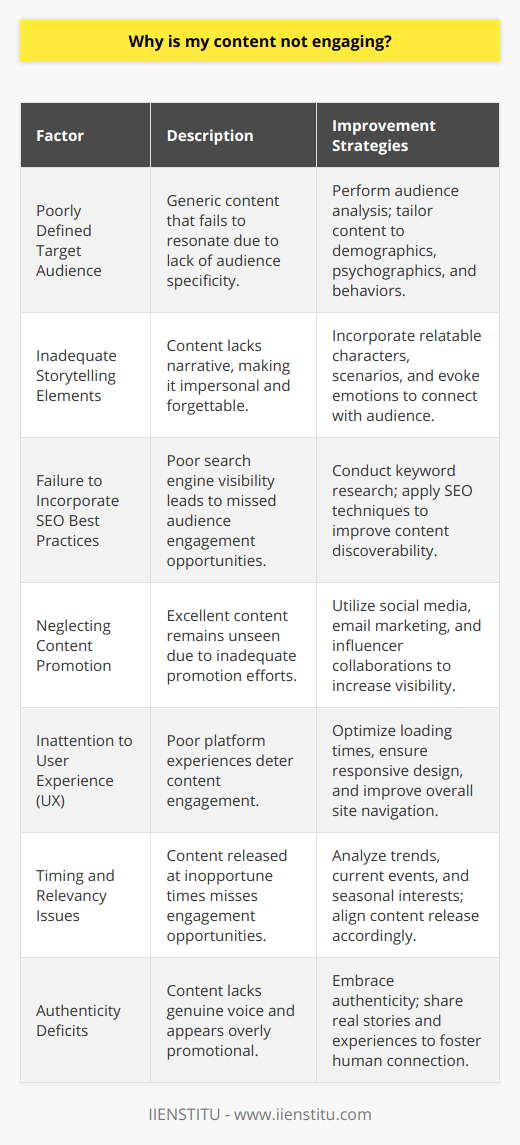
What are your top 3 rules for writing engaging content?
**Rule 1: Knowing the Audience**
The foremost priority in writing captivating blog posts is understanding the target audience. By comprehending readers' unique interests and preferences, content creators can curate their work to maintain relevance and appeal to their readership base.
**Rule 2: Clarity and Conciseness**
Engaging content relies heavily on the utilization of clear and concise language. Careful selection of simple words and short sentences contributes to improved readability, ensuring readers remain interested and informed throughout the piece. Avoiding jargon, unnecessary verbosity, and complex sentence structures facilitates this goal.
**Rule 3: Incorporating Storytelling Techniques**
Incorporating storytelling techniques remains an essential aspect of crafting engaging content. By weaving a narrative throughout the blog post, writers can evoke emotions and create reader connections. Using relatable examples, anecdotes, or metaphors enables the audience to grasp abstract concepts and retains their interest in the subject matter.
In conclusion, to generate engaging content for blog posts, writers should prioritize understanding their audience, maintain clarity and conciseness in language, and utilize storytelling techniques. These rules promote an enjoyable and informative reading experience while cultivating a loyal readership.

What techniques can be utilized to capture and maintain a reader's attention throughout an entire piece of content?
Techniques for Engaging Readers
Variety of Content Formats
To maintain a reader's attention throughout a blog post, implement various content formats such as images, videos, infographics, and data visualizations. These multimedia elements support the text by illustrating points visually, breaking up large blocks of text, and appealing to diverse learning styles.
Compelling Storytelling
Weaving a captivating narrative engages the reader on an emotional level, making the content more relatable and memorable. Utilize storytelling techniques such as anecdotes, personal experiences, and case studies to create a connection with the reader and humanize complex concepts.
Clear and Concise Writing
Employ clear and concise language to convey the intended message effectively. Short, straightforward sentences contribute to improved readability and comprehension. Eliminate unnecessary jargon and technical terms, or provide explanations for terms integral to the discussion.
Logical Structure and Organization
Organizing the content with a logical structure and incorporating subheadings aids readers in comprehending the flow of ideas. Subheadings act as signposts, allowing readers to quickly scan and locate relevant information.
Incorporation of Relevant Examples
Including relevant examples, case studies, and real-life situations demonstrates the practical applications of the concepts discussed. These examples help establish credibility and enable readers to visualize the ideas in action, leading to better understanding and retention.
Addressing Multiple Perspectives
Address different perspectives, acknowledging alternative viewpoints and possible objections to the argument. This balanced approach showcases thorough research and fosters critical thinking, stimulating readers' interest and enhancing credibility.
Active Voice and Strong Verbs
Utilize active voice and strong verbs to create a sense of energy and engagement within the text. Active constructions result in more dynamic and confident writing, contributing to an overall compelling reading experience.
Thought-provoking Questions
Pose thought-provoking questions that challenge readers to reflect on the content and consider different perspectives. This interactive approach encourages reader participation, contributing to a deeper connection with the material.
Closing Summary and Call-to-Action
Conclude the blog post with a strong summary that reiterates the main points and emphasizes the relevance of the topic. A clear call-to-action encourages readers to engage further with the content or participate in an ongoing discussion.
In conclusion, harnessing a combination of multimedia elements, storytelling techniques, clear language, logical organization, and reader-engaging strategies can effectively capture and maintain a reader's attention throughout an entire piece of content. When executed skillfully, these techniques lead to a more enjoyable and immersive reading experience, ensuring readers remain engaged from beginning to end.
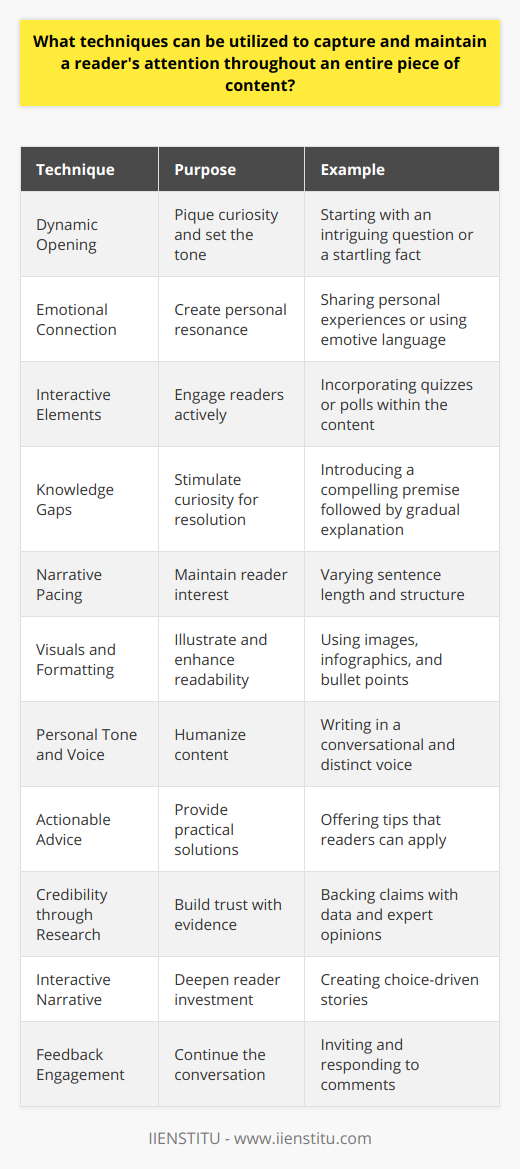
What is the significance of understanding one's target audience in creating engaging content?
Understanding the Audience's Needs
Understanding one's target audience provides an advantageous position when creating engaging blog content. The significance lies in offering value and relevancy. Important demographic factors such as readers’ age, gender, location, and interests shape the style and substance of the post.
Aligning Content with Expectations
Target audience cognitive processing also impacts engagement. By understanding the audience's knowledge base and cognitive capabilities, bloggers can tailor content complexity, ensuring it is neither too simplistic nor overly complicated. Thus, ensuring higher engagement and meeting audience expectations.
Creating Personalized Engagement
This personalized approach enhances engagement. By understanding the audience's challenges, desires, and motivators, bloggers can make the content user-centric. They can provide the much-needed solutions, stir emotions or provoke thought. This enriches the audience's interaction and experience with the content.
Influence on Reader's Actions
This can even influence the reader's actions. When the content resonates with the audience's needs and preferences, it increases the likelihood of sharing, subscribing or taking any other intended actions, thus ensuring the blog's success.
In conclusion, understanding the target audience forms a crucial prerequisite for creating engaging blog content. It influences not only what we write but also how it is written, presented, and consumed. Therefore, audience understanding should be a strategic priority for any blogger aiming to create engaging content.
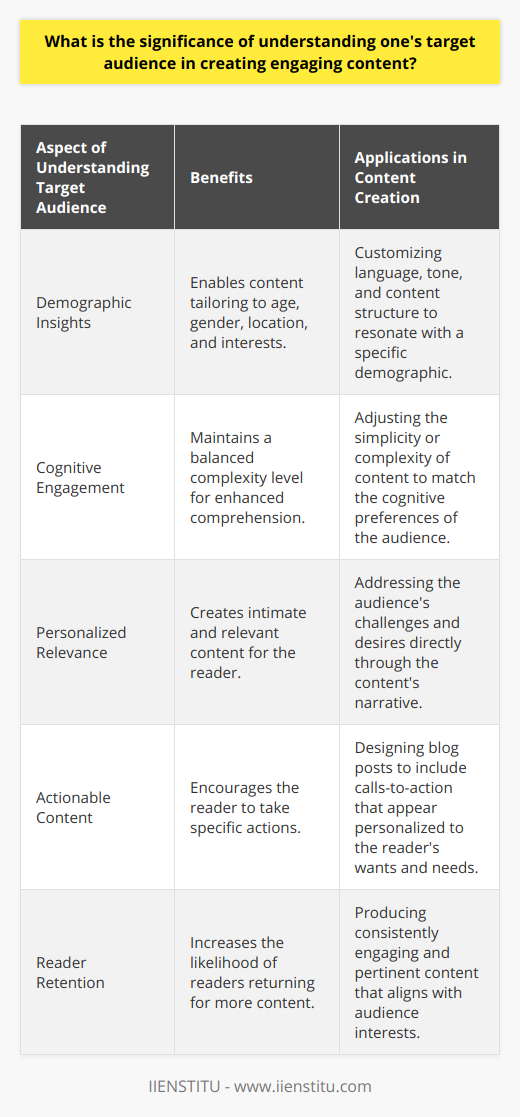
How do multimedia elements, such as images and videos, impact the level of audience engagement with content?
Effect of Multimedia on Audience Engagement
Multimedia elements, like images and videos, can markedly enhance audience engagement. They capture attention, evoking strong emotional responses, thus making the content more memorable.
Attraction and Retention
First, images and videos attract more attention than text-only content. They entice the eye with color and movement, making people more likely to click and read. Including such rich visuals can lead to higher traffic and more time spent on a blog post.
Emotional Connection
Secondly, multimedia helps blogs forge strong emotional bonds. Images and videos can summon feelings more effectively than text. This emotional impact can impress content on the mind and heart of the audience.
Retention and Sharing
Lastly, people remember visually-presented information more than text. Retention increases, thereby boosting audience engagement. Additionally, audience members are more likely to share blog posts that include multimedia
In conclusion, incorporating multimedia elements into blog posts significantly increases audience engagement. It aids in attraction and retention, helps create an emotional connection, and increases content sharing. Therefore, blog authors should consider using images and videos to engage their audience more effectively.

Are there any content structures or formats that have been proven to be more effective in fostering engagement among readers?
Effective Content Structures for Reader Engagement
Understanding content structures is crucial for engaging blog readers. Specific structures and formats can captivate readers and foster engagement more effectively.
Role of Content Formats
Different formats can cater to various reader behaviors. Listicles (list-based articles) serve avid 'skimmers' and 'scanners'. They provide readers with bite-sized information, thereby creating a more engaging experience. Further, how-to guides and tutorials prove beneficial for readers seeking in-depth knowledge.
Power of Multimedia
Integrating multimedia elements, such as images, infographics, and videos, can boost reader engagement. Visual content assists in breaking text monotony and enhancing comprehension. Moreover, video content can hold readers' attention better, making the content more interactive and engaging.
Engagement through Interactivity
Including interactive content forms like quizzes, polls, and surveys not only engages readers but also encourages active participation. This technique transforms passive reading into a two-way communication process.
Value of Headers and Subheaders
Using headers and subheaders can guide readers through the content journey. Breaks within the content enable easier absorption of information and maintain reader interest.
Emphasis on Short Paragraphs
Short paragraphs and sentences help make the content reader-friendly. The prospect of consuming large chunks of text can be daunting. Dividing content into smaller sections increases its digestibility and keeps readers engaged.
Importance of Readability
Ensuring readability goes beyond the use of simpler words and shorter sentences. Incorporating white space, bullet points, and text highlighting can significantly improve the reading experience and boost engagement.
In conclusion, an effective content structure and format contribute significantly to engendering reader engagement. Integrating varying formats, multimedia elements, and readability strategies can prove instrumental in garnering reader interest and participation.
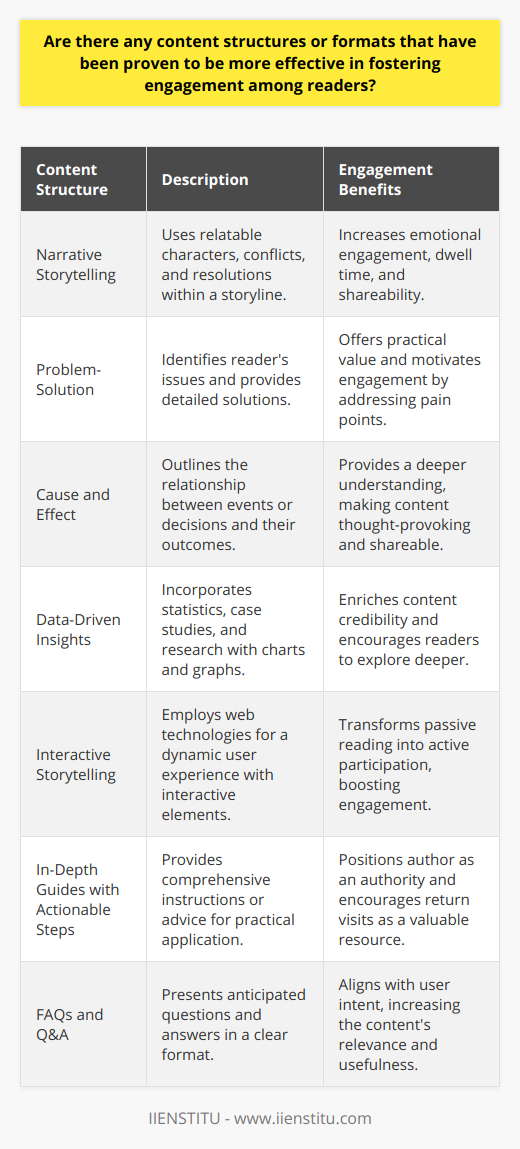
How do I make my social media content more engaging?
Content Strategy for Social Media Engagement
Making social media content more engaging involves focusing on various content strategies. One possible approach is sharing visuals. Posts with images, videos, or infographics have proven to be more engaging than plain text.
Prioritize Interaction - The Art of Responding
Encouraging interactions from your audience is essential. You can stimulate conversations by posing questions or starting discussions. Further, audiences appreciate attentive brands. Responding to comments and messages not only boosts engagement but also promotes positive brand perception.
Refined Content - Quality over Quantity
Creating quality content should take precedence over quantity. Consistently producing high-quality content holds the interest of your audience, keeping them attentive and engaged. Additionally, content must also be relevant and timely to remain attractive to your audience.
Voice of Brand - Authenticity and Consistency
Maintaining an authentic voice that represents your brand is vital. A distinctive and consistent voice humanizes your brand, fostering a connection with your audience. This authenticity can create a faithful following and higher engagement.
Strategic Timing - Use of Analytics
Consider when your audience is most active online. Posting content during peak hours increases visibility. Usage of analytics tools can provide insights into optimal posting times, leading to higher engagement.
User-Generated Contents - Involve Your Audience
User-generated content can deepen audience involvement. Encourage your audience to share their experiences or ideas related to your brand. Not only does this highlight your consumers' voices, but it also fosters a deeper brand connection and encourages engagement.
In conclusion, creating engaging social media content calls for keen attention to interaction, content quality, brand voice, timing, and user participation. Implementing these strategies can drastically improve the level of engagement with your social media content.
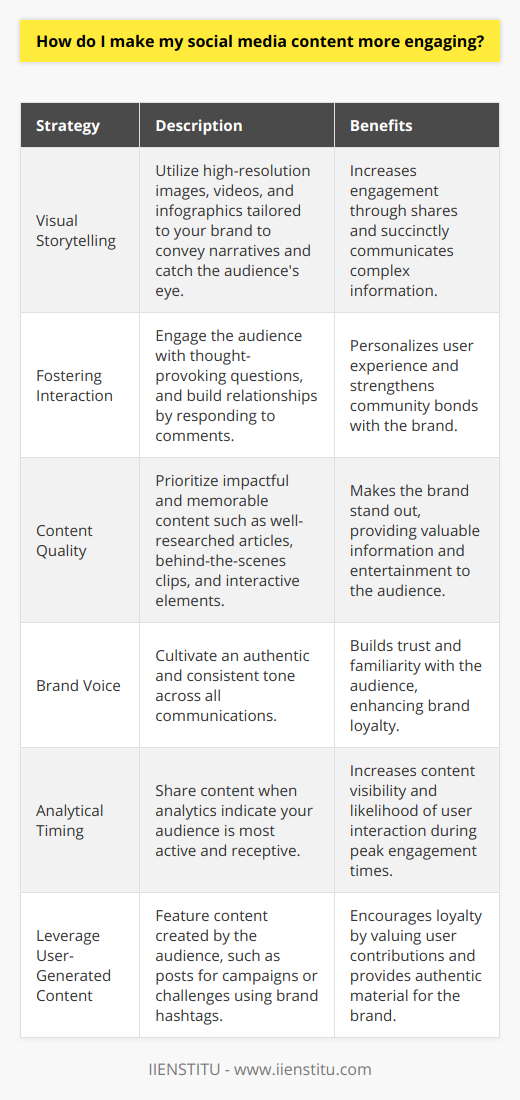
How do you build engaging content that maintains the reader's attention throughout the entire piece?
Understanding Reader's Interests
To build engaging blog content that holds the reader's attention, understanding the reader's interests is crucial. Recognize the audience and tailor the content accordingly.
Inclusions of Relevant Images
The usage of relevant images can act as an attention grabber. They can break the monotony of text and make the blog post visually appealing.
Create Digestible Content
Content digestion is another essential aspect. Content should be simple and written in layman's terms making it easier for the readers to understand. Long sentences and jargons can confuse the readers and may lead them to lose interest.
Effective Use of Subheadings
Subheadings function to break down the information. They ensure that the content remains organized, and readers can easily navigate. They play a significant role in increasing the readability of a blog post.
Incorporation of Stories
Stories can build an emotional connection with the readers. Incorporating them can help maintain the engagement level throughout the blog post.
Asking Engaging Questions
To build the readers' interest, asking engaging questions makes them participate in thinking process. This developed sense of participation maintains engagement throughout the blog post.
Build Suspense
Creating suspense can make the readers anticipate what is to come next. This strategy can keep the readers hooked until the end.
In conclusion, to build engaging blog content, seeking the reader's interests, using relevant images, creating digestible content, effective usage of subheadings, incorporating stories, asking engaging questions, and building suspense are useful approaches. Paying attention to these techniques will surely lead to the creation of content that maintains reader engagement throughout the blog post.
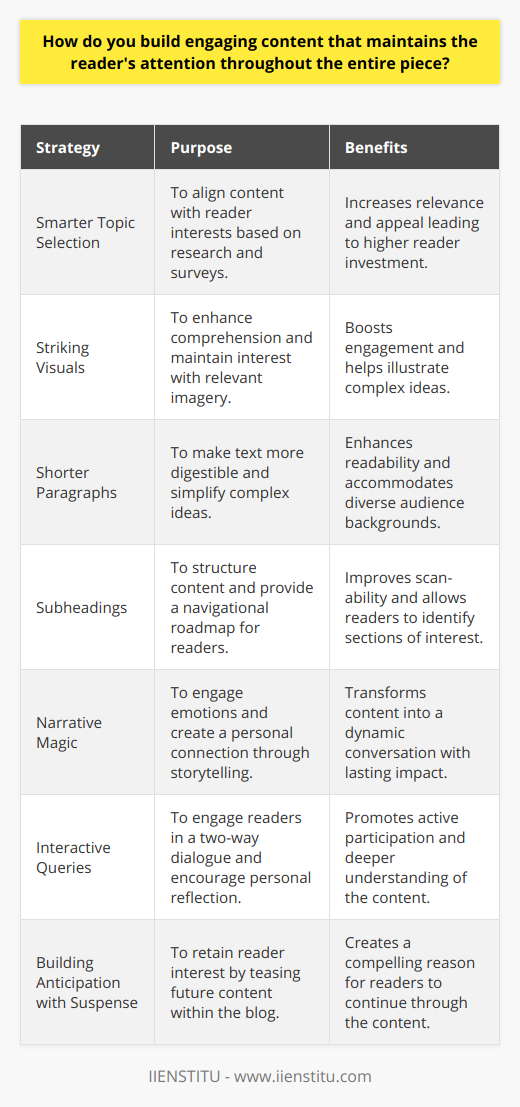
What role does understanding one's target audience play in the creation of captivating and relatable content?
Understanding the Target Audience's Significance
Understanding one's target audience is critical in crafting captivating and relatable blog content. It fundamentally determines the relevancy, depth, and appeal of the content being presented.
Relevancy of Content
Knowing the preferences, needs, and interests of the target audience allows for crafting content that is highly relevant to them. Without comprehending these factors, the content risks being disjointed and lacking resonance amongst the readership.
Depth of Content
Furthermore, when a blogger is aware of their audience's level of understanding and interest about the topic, they can appropriately decode the content. They may simplify intricate concepts for novices, or delve deeper into specialized topics for non-lay readers. Thus, understanding the audience prevents unnecessary complexity or triviality in content presentation.
Appeal of Content
Understanding one's audience also maximizes the appeal of the blog content. This knowledge dictates the tone, style, and format of the content to align it with the audience's preferences and expectations. Crafting content that resonates with the audience's tastes not only piques their interest but also fosters a deeper connection to the blog itself.
In Conclusion
In sum, understanding one's target audience plays a pivotal role in creating captivating and relatable blog content. It ensures the birth of relevant, appropriately tailored, and appealing content, resulting in a more successful blog and a more engaged readership. Achieving optimal success and engagement, however, hinges upon a clear and thorough understanding of the target audience. Therefore, it is advice to bloggers to invest the necessary time and effort into uncovering their readership's needs, interests, and preferences.
